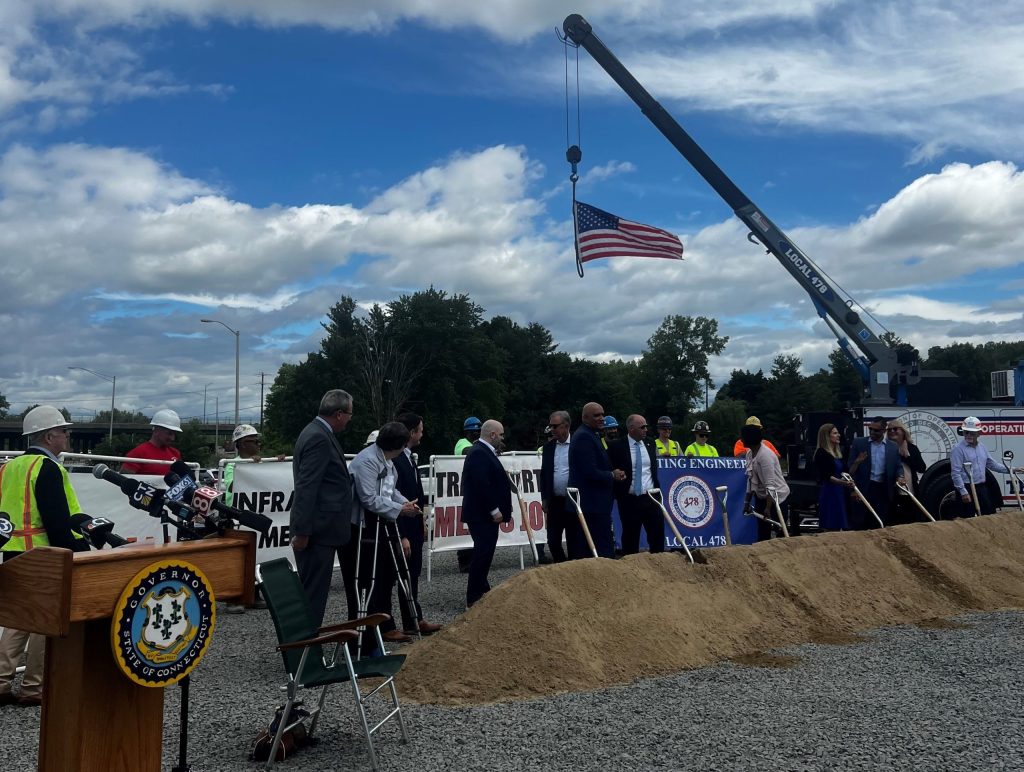Gov. Ned Lamont led a celebration Tuesday of a major highway project that comes as the construction industry is expressing frustration with the pace of shovel-ready plans being produced by the state Department of Transportation.
Lamont and Commissioner Garrett Eucalitto of DOT hosted a groundbreaking marking the second phase of a three-phase plan for traffic mitigation and safety measures on the I-91, I-691 and Route 15 interchange in Meriden.
“Here in Meriden, we call ourselves ‘the crossroads of Connecticut,’ centrally located,” Mayor Kevin Scarpati said at press conference just off the on-ramp onto Route 15. “But what good is it to be the crossroads of Connecticut if those roads are congested on a daily basis?”
The first two phases cost $135 million in state funding and $200 million in federal funds from President Biden’s Bipartisan Infrastructure Investment and Jobs Act. The program in its entirety will cost over $500 million, 80% of which will be covered federally, Eucalitto said.
The interchange is one of the “worst bottlenecks” in the state, Eucallito said.
The interchange, which mostly features short single-lane ramps on and off the highway, was completed in the 1960s in an era of lower traffic volumes.
Now, the “mess of spaghetti,” as Eucalitto described it, is just not cutting it for Connecticut drivers: Fender-benders and traffic delays are all too common.
The project, which features multilane ramps, added auxiliary lanes and sound barrier walls, aims to alleviate backed-up roads and bridges projects that cost the state more than $6 billion annually and $2,300 per driver in operating costs.
Project labor agreements, which include terms and conditions for the work’s quality and safety, are another important facets of the project, said Andrew Inorio, the business manager of the local Laborers Union.
“This is not about a job here today but careers for the next generation of construction workers here in Connecticut,” Inorio said. “These men and women will build the roads and bridges that we will all someday drive on … Without their dedication to their crafts, jobs like these don’t get built to the highest standard of quality.”
The project was originally proposed over a decade ago, according to Eucallito and Scarpati. However, it was “shelved due to a lack of funding.”
Biden’s bill was passed in November 2021. Lamont and the DOT’s project began in October 2023, almost two full years later. During that time, state Special Transportation Fund dollars came pouring in from fuel, sales and mileage taxes. But not all of the money was spent, causing frustration among construction advocates.
“I have companies coming to me saying, ‘I need work to keep my people busy’,” said Don Shubert, the president of the Connecticut Construction Industries Association. “They got Connecticut workers working in New York, working in Massachusetts, working in Rhode Island. They should be here, working in Connecticut.”
Shubert is an invited guest at every DOT groundbreaking, but he also is a constant voice demanding the state fully take advantage of the available federal funding. Three years after passage of the federal infrastructure law, federal transportation funding has grown over 40%, but state bonding for matching funds that are needed to use the funding have not grown commensurately.
Connecticut ranked 50th among the states in spending funds from the Biden infrastructure program in its first two years, Shubert said.
The Meriden project will be 15% funded with state money, Lamont said.
Eucalitto said the state is aggressively seeking and using federal funds — and the result is evident in highway projects around the state.
“We’ve never left any federal funds on the table. We’ve spent every federal dollar we get. And I think if you drive around, people are getting frustrated about how much construction we have going on,” Eucalitto said.
Those projects include reconstruction of the Gold Star bridge carrying I-95 over the Thames River. The rebuilding of the I-84/Route 8 mixmaster in Waterbury will finish this year.
“So folks from Waterbury will be happy about that,” Eucalitto said. “But … every corner of the state has projects, major projects underway.”
Shubert said the industry was unhappy with the state’s use of $500 million, slightly more than half the reserve in the Special Transportation Fund, to pay down bonding debt.
Nine years ago, lawmakers moved a large chunk of sales tax revenues into the state’s Special Transportation Fund. Despite the 57% increase in state funds since 2015, projects were slow to get underway. Even after Biden’s infrastructure bill was put into place in 2021, however, projects continued to stall.
Eucalitto said the state wasn’t hesitating to spend transportation money.
“We’ve never left any federal funds on the table. We’ve spent every federal dollar we get. And I think if you drive around, people are getting frustrated about how much construction we have going on,” Eucalitto said.
CT Mirror staff writer Mark Pazniokas contributed to this report.

